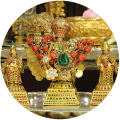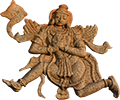Śrī Raghunātha Tīrtha

Tenure : 1700 – 1755
Ārādhana : Āṣāḍa śukla caturthī
Location : Tirumakkūḍalu
Charama Shloka :
ಸರ್ವಸರ್ವಂಸಹೇಶಾನಾಂ ಸಭಾಸು ಜಿತವಾದಿರಾಟ್ | ಸರ್ವದಾ ಸರ್ವದೋ ಭೂಯಾದ್ರಘುನಾಥಮುನೀಶ್ವರಃ ||
सर्वसर्वंसहेशानां सभासु जितवादिराट् | सर्वदा सर्वदो भूयाद्रघुनाथमुनीश्वरः ||
sarvasarvaṃsaheśānāṃ sabhāsu jitavādirāṭ | sarvadā sarvado bhūyādraghunāthamunīśvaraḥ ||
About Śrī Raghunātha Tīrtha
Śrī Raghunātha Tīrtha was ordained the 22nd Pīṭhādhipati by Śrī Lakṣmī Nārāyaṇa Tīrtha.
We understand that from tradition that Śrī Raghunātha Tīrtha was born in Gudibaṇḍe of Kolar Taluk. He had his Śāstraic education at Kāśi and turned out to be a young eminent scholar in his Pūrvāśrama. Subsequently, he came under the tutelage of his Guru Śrī Lakṣmī Nārāyaṇa Tīrtha – who after ordaining him to the Pīṭha, entrusted the Saṁsthāna amid all scholars and disappeared.
The Saint is one of the very few to have adorned the Pīṭha for a relatively long period of time. He was well-known by his honorary name Śeṣacandrikācārya for having enlivened the glory of the Śrīmaṭha and Candrikācārya during his tenure. This is clear from the number of epigraphical records proclaiming recognition of the Śrīmaṭha as ‘Śrimat Vyāsarāyara Vidyāsiṁhāsana’ and the saint as ‘Śrī Raghunātha Tirtha Pujya Sripada’ that record various grants made by rulers of his time in the southern states.
Few similes noticeable on the honorary name between him and his famed predecessor are: Śrī Vyāsa Tīrtha who was also called Candrikācārya was the Śiṣya of Śrīpādarāja whose original name was Śrī Lakṣmī Nārāyaṇa Tīrtha: Lakṣmīnārāyaṇa Munīn Vande Vidyā Gurun Mama while Śrī Raghunātha Tīrtha or Śĕṣacandrikācārya was the Śiṣya of Śrī Lakṣmī Nārāyaṇa Tīrtha as well. Further, both saints seem to have adopted the fourth order at a very young age. Candrikācārya’s prayer was composed by his direct disciple Śrī Vījayīndra while Śeṣacandrikācārya’s prayer was composed by two later saints in the tradition: Śrī Vidyākānta Tīrtha and Śrī Vidyaratnākara Tīrtha
Tradition records that when Śrī Vyāsa Tīrtha was asked why he had left half of his Tātparya Candrika – one of the three stellar compositions of the Śrī Vyāsa Tīrtha collectively known as ‘Vyāsa Traya’s, the other two being ‘Nyāyāṁruta’ and ‘Tarka Taṇḍava’- incomplete, he seems to have replied ‘Daśamo Matsamo Bhavet’ indicating that the tenth saint from him that occupies the Pīṭha would be the one to finish the task. This prophecy was to come true after a gap of around two hundred years when Śrī Raghunātha Tīrtha appeared on the Parampara, as predicted earlier. ‘Śeṣa’ means ‘remaining or left-over’ and as Śri Raghunātha Tīrtha completed the second-half of ‘Tātparya Candrika’ that was left-over by Śrī Vyāsa Tīrtha, tradition offered the Honorary Title ‘Śeṣacandrikācārya’ for this saint.
The saint was knowledge-personified – Padavākya Praṇambŏnidhi Pariṇa – on different branches of religion and philosophy: He was a prolific composer of Śāstraic literature that were abstruse and variegated and a feared and respected debater well-known for his polemical achievements – Sabhāsu Jitavādiraṭ. Records available within tradition – as well as the previously listed ones – demonstrate that he travelled extensively to propagate Tattvavāda, bless devotees and perform other duties related to the Piṭha. The saint has a few more excellent compositions besides the ‘Śeṣa Tātparya Candrika’ to his credit, which scholars opine are replete with rare details, extremely refreshing, extensive and of enormous internal value.
We understand from tradition that the saint was unwell midway through his recorded tenure and ordained one of his disciples to the fourth order – Sanyāsāśrama – with the appellation Śrī Lakṣmīnidhi Tīrtha. However, he seemed to have recovered and continued to occupy the Piṭha. Based on Epigraphical records, we understand that Śrī Lakṣmīnidhi Tīrtha should have undertaken some travel at this time on behalf of the Śrīmaṭha but attained Haripāda prematurely, even during the tenure of the saint. The Vṛndāvana of Śrī Lakṣmīnidhi Tīrtha was consecrated in Śrīraṅgam in the same complex that housed his predecessors’ Vṛndāvanas. Shortly afterward, the saint seems to have anointed Śrī Jagannātha Tīrtha to the fourth order.
It is traditionally believed that he spent most of the time in the Kumbhakoṇa Maṭha -acquired as a gift by Śrī Rāmacandra Tīrtha – tutoring Śrī Jagannātha Tīrtha. During his final days, he seems to have undertaken a visit to Bannur and Śrīraṅgapaṭṭaṇa and reached Trimakuṭa Kṣetra along with Śrī Jagannātha Tīrtha. The saint’s guru Śrī Lakṣmīnārāyaṇa Tīrtha had consecrated the vigraha of Śrī Mukhyaprāṇa right beneath the Brahmaśvatta Vṛkśa – Banyan tree – performed his penance and taught him there.
The Saints seem to have spent some time in the same place. Śrī Raghunātha Tīrtha handed over the Pīṭha to Śrī Jagannāṭha Tīrtha and attained Haripāda right there. The Vṛndāvana of His Holiness stands in the same place now. We understand from tradition that when an effort was made to displace the Vṛndāvana to a different location with inappropriate intentions, Almighty created a dream in the deciding authority and enacted a heart-rending scene involving the saint to ensure that the saint’s penance is not disturbed!
Śrī Vidyāprasanna Tīrtha has composed a couple of wonderful devaranamas in chaste Kannada language that provide a good poetic picture of this Saint.
PS: Śrī Raghunātha Tīrtha had presented the idol of Śrī Mukhyaprāṇa – that for which he performed pooja for many years – to the ancestors of Śrī Balācārya’s – Pūrvāśrama Nāma of Śrī Santhuṣṭa Tīrtha of Uttarādi Maṭha – honouring their knowledge.


